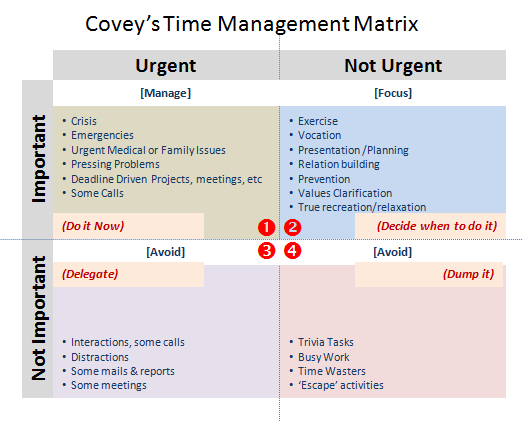Good time management is something that often sounds easy in theory but in practice can often prove elusive. For managers, the difficulty comes from having to juggle your day to day workload with managing a team of people and all the unpredictability that brings.
Good time management isn’t just about becoming more efficient at the things you do, but starts with prioritising the way you spend your time, something Thomas Davies of Google refers to as ‘designing your time’.
I love the idea that you can design your time and this concept is very much at the heart of one of the simplest and yet most powerful time management systems around: Covey’s Matrix.
What is the Matrix?
Covey’s Matrix works by allocating work into one of four quadrants on a 2×2 grid to identify its importance and its urgency (see image below). Each quadrant in the matrix can change in size but the overall size of the matrix represents the set number of hours in a given working day, week or month and therefore cannot change.

The simplicity of Covey’s Matrix belies a cunning efficiency in the way it forces people to think about how important or urgent a task is. Categorising your time and deciding which quadrant it falls into helps you focus on what is important and what isn’t. Generally speaking, those who are able to increase the work that falls into the important and not urgent category are better at managing their time efficiently.
Let’s now look at each quadrant in turn.
Important and Urgent (Quadrant of Necessities)
Many tasks you undertake on a day to day basis will be both important and urgent. These are often unavoidable and more often than not reactive (like answering important calls and dealing with crises and emergencies). Working to externally imposed deadlines also falls into this category. These tasks can be better managed by staying on top of deadlines and giving yourself the capacity to deal with a crisis should it arise.
The problem for many people is that important but non-urgent work often falls into this category because deadlines have been allowed to slip. Even worse; it’s possible for work that is neither important or urgent can also end up falling into this quadrant. By spending more time in Covey’s second quadrant though, it is possible to mitigate against both these scenarios.
Important and not Urgent (Quadrant of Quality)
The so-called quadrant of quality is the place you ideally want to be spending more of your time. This is where your pro-active time lives, as well as relaxation and downtime. Of course it’s unrealistic to suggest that you could spend anything approaching most of your time in here, but the more you can then the more you will benefit in the long run.
Being proactive allows you to head off deadlines and crises before they loom large and fall into quadrant one, forcing you to drop everything to deal with them. Team management and relationship building also falls into this quadrant, two activities that have a number of long term benefits.
Not Important and Urgent (Quadrant of Deception)
This quadrant is undoubtedly the area into which a lot of people’s time gets sucked on a day to day basis. These are the distractions and seemingly unavoidable tasks that fill up the parts of your day you’d really prefer to be putting to good use. These tasks may seem urgent but with some honest inspection can be categorised as non-urgent. For managers, it’s important to reduce the workload in this quadrant by learning the art of delegation and monkey management.
Not Important and Not Urgent (Quadrant of Waste)
Some tasks are neither important nor urgent and it is in this quadrant where some of the easiest and quickest wins can be made when it comes to wrestling back time to spend on more important work. Identifying tasks that should be ditched means thinking hard about what benefits they bring and if those benefits are worth the work put in. If not then it means learning to say no. As with the previous quadrant, staff offloading minor problems onto your shoulders can fall into this camp.
Conclusion
Covey’s Matrix may not be a silver bullet to time management but it arms you with a framework to identify wasted and productive time and make changes. As I’ve already mentioned, a large part of this change is learning to say ‘no’ and adopt good monkey management practices by agreeing to manage your staff’s problems, instead of just taking them on your shoulders.
Like all good time management practices though, Covey’s Matrix is only effective if you avoid the temptation to put things off and make the changes necessary. If you do, you might find yourself with a lot more time on your hands.


Peter
Thanks for the contribution, I though you might like to know this page has had 949 views in the past 2 -days